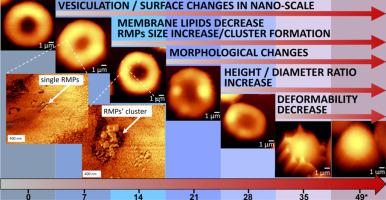Nanomedicine: Nanotechnology, Biology and Medicine ( IF 4.2 ) Pub Date : 2020-05-08 , DOI: 10.1016/j.nano.2020.102221 Magdalena Kaczmarska 1 , Marek Grosicki 1 , Katarzyna Bulat 1 , Mateusz Mardyla 2 , Ewa Szczesny-Malysiak 1 , Aneta Blat 3 , Jakub Dybas 1 , Tomasz Sacha 4 , Katarzyna M Marzec 1

|
Based on the multimodal characterization of human red blood cells (RBCs), the link between the storage-related sequence of the nanoscale changes in RBC membranes in the relation to their biochemical profile as well as mechanical and functional properties was presented. On the background of the accumulation of RBCs waste products, programmed cell death and impaired rheological properties, progressive alterations in the RBC membranes including changes in their height and diameter as well as the in situ characterization of RBC-derived microparticles (RMPs) on the RBCs surface were presented. The advantage of atomic force microscopy (AFM) in RMPs visualization, even at the very early stage of vesiculation, was shown based on the results revealed by other reference techniques. The nanoscale characterization of RMPs was correlated with a decrease in cholesterol and triglycerides levels in the RBC membranes, proving the link between the lipids leakage from RBCs and the process of vesiculation.
中文翻译:

应用原子力显微镜和补充技术,在纳米级观察到人类红细胞的囊泡的时间序列。
基于人类红细胞(RBCs)的多峰表征,提出了RBC膜的纳米级变化的存储相关序列与它们的生化特性以及机械和功能特性之间的联系。在RBC废物积聚,程序性细胞死亡和流变特性受损的背景下,RBC膜的进行性改变包括其高度和直径的变化以及RBC上RBC衍生微粒(RMP)的原位表征提出了表面。基于其他参考技术揭示的结果,即使在囊化的早期,原子力显微镜(AFM)在RMP可视化中的优势也得到了证明。











































 京公网安备 11010802027423号
京公网安备 11010802027423号